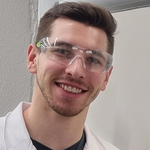
Distillation under inert gas asatmosphere
Mastering the basics of the Schlenk line is essential for any chemist working with air- and moisture-sensitive compounds. In this article, Dr. Andryj Borys, a renowned expert in the field of synthetic chemistry, provides a clear and practical introduction specifically to the vacuum requirements for Schlenk line applications. He offers valuable tips on selecting the right components and optimizing their use in the lab. Whether you’re new to Schlenk lines or looking to refine your setup, this guide will give you the essential knowledge needed to confidently handle complex reactions in controlled atmospheres.
- Schlenk lines are a hybrid piece of equipment/glassware which are commonplace in many synthetic chemistry laboratories as they enable the safe manipulation and handling of air- and moisture-sensitive chemicals and is particularly suited for solution-state techniques.
- Schlenk lines contain a vacuum and inert gas manifold which are interconnected and independently controlled using usually greased ground glass double oblique stopcocks or greaseless Teflon pistons.
- The vacuum component of Schlenk lines has numerous uses, which combined with the facile switch to inert gas atmospheres, facilitates a myriad of processes from synthesis to separation to purification.
The choice of vacuum pump used for Schlenk line techniques depends on specific applications and overall sensitivity of the chemistry. Learn more: Vacuum Pump Selection Guide

Example of a diaphragm pump,
PC 3001 VARIO select
Types of vacuum pumps
Diaphragm pumps
Diaphragm pumps can achieve ultimate vacuum pressures down to 1 mbar and benefit from being oil-free, low-maintenance and chemically resistant, giving them a very long service life. Whilst diaphragm pumps are generally not suitable for performing advanced Schlenk line techniques requiring high-vacuum, they may be sufficient for synthetic/catalytic procedures that require the use of an air- and moisture-sensitive reagent/catalyst but where the final product itself is stable under aerobic conditions.
Diaphragm pumps can be suitable for cycling glassware onto the Schlenk line to remove air and moisture, provided that additional cycles (up to 5) are performed. This can be considered a step-up when compared to flushing/purging glassware solely using an inert gas inlet (via a manifold or balloon) – one solution towards this is VACUU·LAN, a dedicated local area vacuum network which allows multiple workstations to be connected to a central diaphragm pump with integrated vacuum taps fitted in the fumehood.
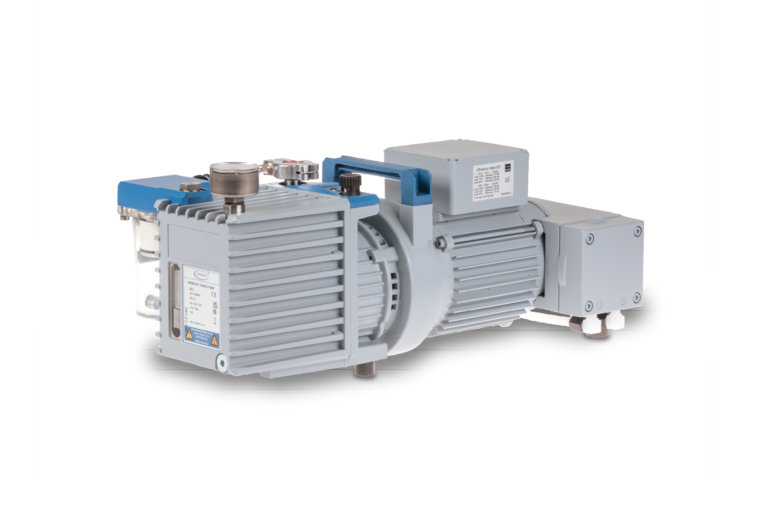
RC 6 Chemistry-HYBRID pump
Rotary vane and hybrid pumps
Schlenk lines are typically equipped with rotary vane (RV) pumps which have ultimate vacuum pressures down to 1 x 10-3 mbar. They benefit from being compact and powerful, but have limited chemical resistance and require frequent maintenance (oil changes and gas ballasting) which is often neglected leading to poor performance and reduced lifetimes. Hybrid pumps which combine a RV pump with a diaphragm pump are available, and offer greater pumping capability and resistance to aggressive solvents and vapours.
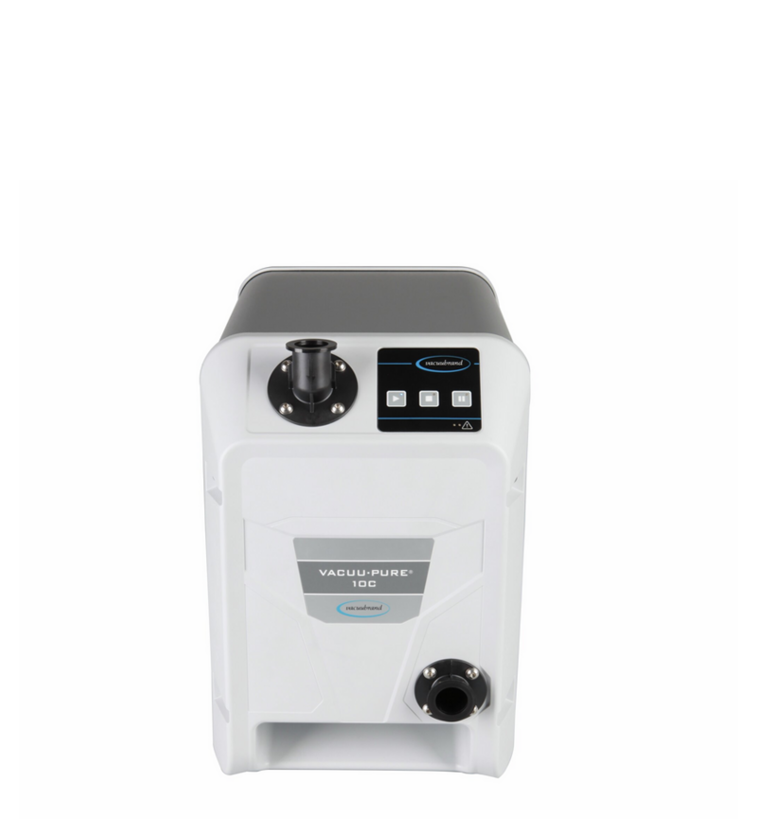
VACUU·PURE® 10C screw pump
Screw pumps
An alternative choice of vacuum pump for Schlenk line applications is the VACUU·PURE 10C screw pump. This offers an ultimate vacuum pressure of 5 x 10-3 mbar without any wearing parts and whilst being 100% oil-free, eliminating the need for frequent gas ballasting and oil changes. The chemical resistance and excellent vapour handling capability of the screw pump allows them to be operated without a cryogenic cold trap for a broad range of applications, since the integrated regeneration mode enables drying of the pump after solvent removal under vacuum. The simple user interface, clear troubleshooting, and minimal maintenance required for the VACUU·PURE 10C screw pump makes them excellent long-term investments for routine and advanced Schlenk line applications.
Oil-diffusion and turbomolecular pumps
High-vacuum lines are closely related to Schlenk lines; these generally avoid the use of hosing and rubber septa and instead rely on direct ground glass or greaseless ball-and-socket joint connections in tandem with vacuum transfer techniques to manipulate liquids and gases. The typical vacuum pressure range for high-vacuum lines is 10-4 to 10-7 mbar; this is unachievable using rotary vane or screw pumps which are limited by the mean free path of gas molecules. Oil-diffusion or turbomolecular pumps are therefore employed for high-vacuum applications, however these must still be used in tandem with diaphragm, rotary vane or screw pumps to serve as a fore (roughing) pump to establish backing pressures between the lower mbar range and 10-3 mbar for safe and efficient operation. The VACUU·PURE 10C screw pump is particularly well suited for use as a fore pump with turbomolecular pumps since both are oil-free and clean technologies.
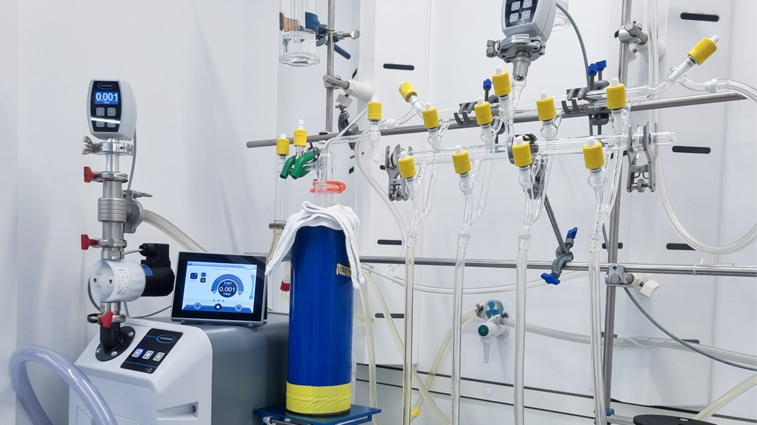
Schlenk line with vacuum pump, gauges and controller
Uses of vacuum on a Schlenk line
Cycling glassware onto the Schlenk line
The primary use of vacuum on a Schlenk line is “cycling” glassware, the process of performing repeated (usually three) vacuum and inert gas cycles to remove air and moisture from oven dried glassware and/or the hosing connecting the Schlenk flask or a sealed reagent/solvent ampoule to the Schlenk line.
A 100 mL flask filled with air contains approximately 1 mmol of O2 at atmospheric pressure (~1000 mbar) which would be detrimental to many oxygen-sensitive organometallic or main-group compounds. Evacuating the flask down to 0.1 mbar reduces the concentration of O2 down to 1 x 10-4 mmol. Backfilling with inert gas and re-evacuating the flask once again to 0.1 mbar lowers this to 1 x 10-8 mmol, and a third cycle lowers this even further to 1 x 10-12 mmol. Importantly, this is several orders of magnitude lower than performing a single evacuation down to 0.001 mbar (1 x 10-3 mbar), the ultimate vacuum of a well-maintained rotary vane vacuum pump. This emphasises the importance of performing multiple vacuum/inert gas cycles and illustrates that even diaphragm pumps (ultimate vacuum around 1 mbar) may be effective at establishing inert atmosphere conditions in the laboratory.
Evaporation of solvent under vacuum
The use of vacuum on a Schlenk line enables the evaporation of solvent and other volatiles whilst maintaining a strictly inert atmosphere. In contrast to rotary evaporators, which typically employ diaphragm pumps with an ultimate vacuum down to 1 mbar, Schlenk lines are commonly equipped with rotary vane pumps, with ultimate vacuum pressures in the 10-3 mbar range. This allows high-boiling solvents such as toluene, DMF and DMSO to be evaporated at room temperature, or for low boiling solvents such as pentane and Et2O to be evaporated at low temperatures, both of which may be necessary when handling and isolating temperature-sensitive compounds. Strong stirring coupled with controlled application of vacuum is necessary to avoid bumping and contamination of the vacuum manifold of the Schlenk line.
An important consideration when evaporating solvent under vacuum on a Schlenk line is the use of traps. Typically cooled using a Dewar of liquid nitrogen (-196 °C), traps condense evaporated solvents, volatile liquids and some gases, which helps to protect the vacuum pump by limiting exposure to aggressive chemicals. It also allows the collected condensate to be discarded in an appropriate waste container. The use of an external solvent trap should be applied when evaporating large quantities of solvent (>50 mL), when removing particularly aggressive/corrosive chemicals, or when removing volatiles that have relatively high (>0 °C) freezing points such as benzene, 1,4-dioxane and DMSO.
Safety consideration
A major safety concern when using liquid nitrogen cooled traps for the removal of solvent under vacuum is the condensation of liquid oxygen. This can occur if there is a leak within the vacuum manifold, attached Schlenk flasks or hosing, and can result in an explosion if the liquid oxygen combines with organic solvents or grease collected in the trap. Dry ice (-78 °C) can be used as an alternative cryogen, however this may be insufficient to condense and trap volatile solvents and vapours, which may lead to vacuum pump damage. A solution to this problem is the use of the VACUU·PURE 10C screw pump, which boasts comparable ultimate vacuum pressures to rotary vane pumps, whilst avoiding the requirement for cryogenic solvent traps in many cases: this also reduces the usage and thus expenditure of liquid nitrogen or dry ice.
Drying solids under vacuum
The vacuum (10-2–10-4 mbar range) offered by Schlenk lines allow solids to be thoroughly dried under dynamic vacuum. This is typically part of an isolation process after evaporating solvent, or following a filtration and crystallisation/precipitation step, and removes residual organic solvent trapped within the solid. Such solids (assuming it is sensitive to air and moisture) are typically isolated and stored within an inert atmosphere glovebox for further handling and analysis. Drying solids under vacuum is also commonly performed to remove residual water, for example from molecular sieves or Celite (diatomaceous earth or kieselgur) and is often coupled with sustained heating above 100 °C. A frequent oversight when drying solids under vacuum is protection of the vacuum pump and vacuum manifold of the Schlenk line due to bumping or dispersion of very fine solids. To avoid this, an external trap can be used (which can be easily separated and cleaned afterwards) or a hosing adaptor fitted with a glass frit or glass wool insert can be employed.
Purification via vacuum distillation and sublimation
Another application of vacuum on a Schlenk line is the purification or air- and moisture-sensitive liquids and solids by vacuum distillation or sublimation. Dynamic vacuum distillations are employed for the purification of high-boiling (>150 °C) liquids, whilst static vacuum distillations are an advanced method coupled with the freeze-pump-thaw method which is used for the purification of low-boiling (<150 °C) liquids whilst minimising evaporative loss. Dynamic vacuum can also be employed for performing sublimations using a cold finger insert or a specially designed sublimation apparatus.
Degassing using the freeze-pump-thaw method
The vacuum of Schlenk lines is also commonly used to perform the freeze-pump-thaw method, which effectively degasses liquids and solutions so that they can subsequently be stored under an inert gas atmosphere, or exposed to a reactive gas. Reactions may also be performed under a static vacuum to facilitate the release of a volatile by-product into the headspace.
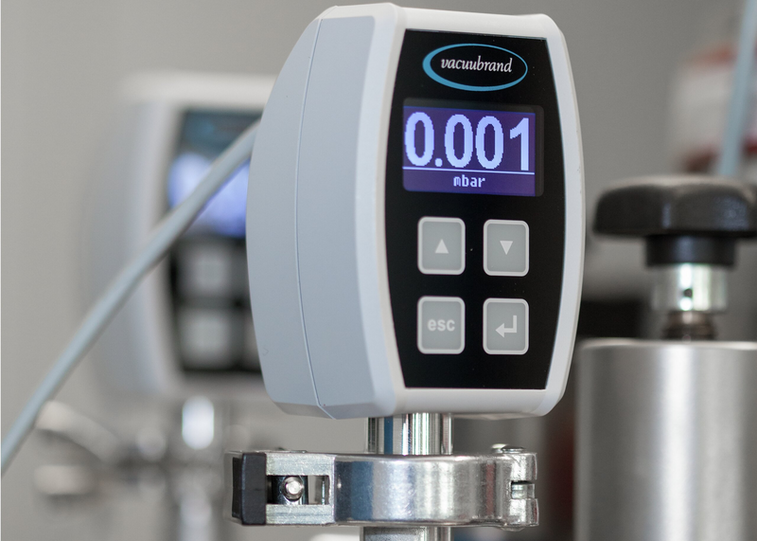
VACUU·VIEW extended vacuum gauge
Vacuum measurement and control
The ability to accurately measure and finely control the vacuum pressure within a Schlenk line ensures that operations are safe and reproducible. The VACUU·VIEW extended vacuum gauge is perfectly suited for Schlenk line applications since it is compact, chemically resistant and measures down to 1 x 10-3 mbar with a digital illuminated display. For permanent fixtures and day-to-day use, vacuum gauges should be attached directly to the vacuum manifold of the Schlenk line using a greaseless O-ring or a KF flange to ground cone adaptor. For Schlenk lines without these connections, a hosing adaptor can be used to periodically check the vacuum pressure and ensure there are no leaks, for example after cleaning and assembly. Vacuum gauges can also be used to measure the vacuum pressure of the pump directly, which can help diagnose if maintenance or further servicing is necessary.
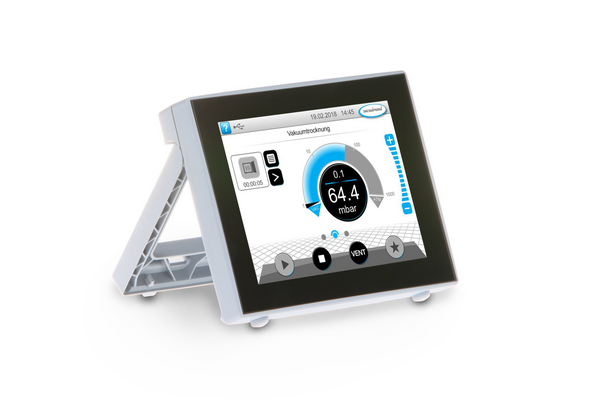
VACUU·SELECT vacuum controller
Whilst vacuum controllers are a common feature of modern rotary evaporators equipped with diaphragm pumps, fine vacuum control for Schlenk line applications is often overlooked. The VACUU·SELECT enables complete control of vacuum pressure from the atmospheric range down to 1 x 10-3 mbar, making it perfectly suited for routine and advanced Schlenk line techniques. In particular, the VACUU·SELECT allows distillations and sublimations to be carried out at specific vacuum pressures, meaning that they are controlled and reproducible. The graphical user interface also allows for easy customisation and access to pre-defined programs for specific applications.
